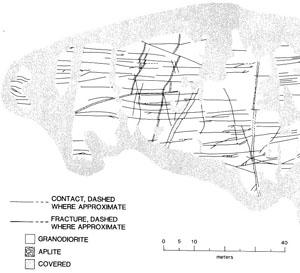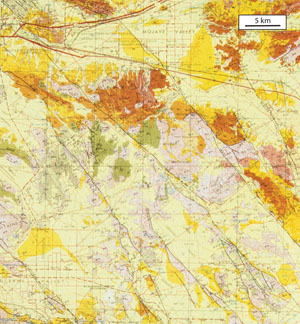| |||||||
|
|
|||||||
|
|
|||||||
| Fault Sets | |||||||
|
A fault set is made up of many parallel or sub-parallel individual faults which have a spatial distribution and spacing (see the 'Fault Spacing Distribution' link below), and accommodate a certain amount of strain. Figure 1 shows a set of normal faults in a mudstone-sandstone sequence exposed on a road cut near Zion National Park, Utah. Figure 2 is a map showing a set of faults on the glaciated surface of granodioritic rock of the Sierra Nevada, California. Here the faults take advantage of an initial system of veins and cut across and displace aplite dikes in a left-lateral sense. This slip creates a new set of splay veins which are shorter and are at an acute angle to the sheared veins. This issue is further discussed in 'Splay Joints' and 'Growth of Faults based on Sequential Shearing of Initial Discontinuities.'
The complexity of a fault set increases as the size increases. Figure 3 is a geological map displaying a set of right-lateral strike-slip faults within the Mojave Desert in southern California. It is certain that what appears to be a simple fault set at the scale of mapping (1/250 000) is much more complex: Each fault is a zone made up of faults in different orientations and sometimes with different senses of slip. These issues are further discussed in specific fault domains in sedimentary and intrusive rocks. Please follow the links below. | |||||||
| Reference: |
|||||||
| Davies, R.K., Pollard, D.D., 1986 Rogers, T.H., Compiler, 1967 Segall, P., Pollard, D.D., 1983 |
|||||||
|
Readme | About Us | Acknowledgement | How to Cite | Terms of Use | Ⓒ Rock Fracture Knowledgebase |
|||||||


